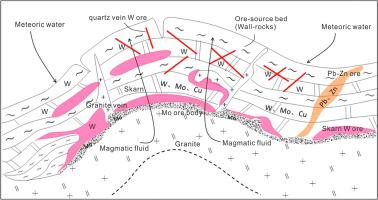当前位置:
X-MOL 学术
›
Ore Geol. Rev.
›
论文详情
Our official English website, www.x-mol.net, welcomes your
feedback! (Note: you will need to create a separate account there.)
Genesis of W–Mo mineralization in the Xiaoliugou and Ta’ergou ore fields, North Qilian Orogen (NW China): Constraints from fluid inclusions and S–Pb–H–O–Nd isotopes
Ore Geology Reviews ( IF 3.2 ) Pub Date : 2020-09-01 , DOI: 10.1016/j.oregeorev.2020.103649 Yu-Chao Wang , Huan Li , Ji-Shun Liu , Tian-Guo Wang , Dao-Han Zha , Chao-Wen Huang , Chen-Guang Zhang
Ore Geology Reviews ( IF 3.2 ) Pub Date : 2020-09-01 , DOI: 10.1016/j.oregeorev.2020.103649 Yu-Chao Wang , Huan Li , Ji-Shun Liu , Tian-Guo Wang , Dao-Han Zha , Chao-Wen Huang , Chen-Guang Zhang

|
Abstract Tungsten–molybdenite (W–Mo) polymetallic mineralization are intensely developed in the western section of the North Qilian Orogen (NW China), represented by the Xiaoliugou and Ta’ergou ore fields. In this study, fluid inclusion microthermometric and S–Pb H O Nd isotopic analyses were conducted on the W–Mo ores to shed insights into the genesis of the mineralization belt. The ore fields are characterized by abundant liquid-vapor two-phase inclusions which have medium–high temperature-salinity (200–320 °C and 4–10 wt% NaCl equiv.). The consistent δ18OV-SMOW (7.7‰ to 13.1‰) and δ2HV-SMOW (−88.1‰ to −49.4‰) values of quartz and muscovite indicate that the ore-forming fluid originated from granitic intrusion but mixed with meteoric water. Typical δ34S values of their sulfide ores range from 6 to 18‰, and the ore-related granites (206Pb/204Pb = 18.18–26.61, 207Pb/204Pb = 15.51–16.02, 208Pb/204Pb = 37.60–39.77) and sulfides (206Pb/204Pb = 17.97–20.06, 207Pb/204Pb = 15.42–16.64, 208Pb/204Pb = 37.39–41.06) have variable Pb/Pb ratios, indicating both magmatic rocks and meta-sedimentary rocks contributed to the mineralization. The negative Nd values (eNd(t) = −9.0 to −3.2) and old two-stage Nd model ages (TDM2 = 1517 to 1901 Ma) of the scheelites suggest that the ore-forming materials may have been derived from old crust together with the granitic magma. An isochron age of 422 ± 42 Ma (initial 143Nd/144Nd = 0.511701 ± 0.000046) has been yielded by the scheelite Sm-Nd dating from the Ta’ergou ore field, implying the 450–420 Ma magmatic–hydrothermal event resulted in the intense W–Mo mineralization in the North Qilian, especially in the western section of this orogen. Consequently, we propose a multi-metal coupled mineralization model to illustrate the mineralization process of the ore fields, which involving the formation of ore source beds (wall-rocks) in Proterozoic and the intrusion of granites in Early Paleozoic. This research highlights the use of multiple isotopic methods in revealing complex fluid evolutionary process of large-scale W–Mo deposits.
中文翻译:

北祁连造山带小柳沟和塔尔沟矿田 W-Mo 成矿成因:流体包裹体和 S-Pb-H-O-Nd 同位素的约束
摘要 以小柳沟和塔尔沟矿田为代表的北祁连造山带西段钨-钼(W-Mo)多金属矿化区非常发育。在这项研究中,对 W-Mo 矿石进行了流体包裹体显微温度测量和 S-Pb H2O Nd 同位素分析,以深入了解矿化带的成因。矿区具有丰富的液-汽两相包裹体,具有中-高温-盐度(200-320°C和4-10 wt% NaCl当量)。石英和白云母的δ18OV-SMOW(7.7‰~13.1‰)和δ2HV-SMOW(-88.1‰~-49.4‰)值一致,表明成矿流体来源于花岗岩侵入体,但与大气水混合。其硫化矿的典型δ34S值为6~18‰,和与矿石有关的花岗岩 (206Pb/204Pb = 18.18–26.61, 207Pb/204Pb = 15.51–16.02, 208Pb/204Pb = 37.60–39.77) 和硫化物 (207.60–39.77), 硫化物 (204.60–39.77), 204Pb/204Pb = 207Pb.204b.204b.204b.204b.206Pb.206Pb.207Pb.204Pb. 208Pb/204Pb = 37.39–41.06) 具有可变的 Pb/Pb 比,表明岩浆岩和变质沉积岩都有助于成矿。白钨矿的负 Nd 值(eNd(t) = -9.0 至 -3.2)和旧的两阶段 Nd 模型年龄(TDM2 = 1517 至 1901 Ma)表明成矿物质可能来自旧地壳与花岗岩岩浆。塔尔沟矿田的白钨矿Sm-Nd测得的等时线年龄为422±42Ma(初始143Nd/144Nd=0.511701±0.000046),表明450-420Ma引发了强烈的岩浆热液事件北祁连的钨钼矿化,特别是在这个造山带的西部。因此,我们提出了一个多金属耦合成矿模型来说明矿区的成矿过程,包括元古代矿源床(围岩)的形成和早古生代花岗岩的侵入。该研究强调了多种同位素方法在揭示大型 W-Mo 矿床复杂流体演化过程中的应用。
更新日期:2020-09-01
中文翻译:

北祁连造山带小柳沟和塔尔沟矿田 W-Mo 成矿成因:流体包裹体和 S-Pb-H-O-Nd 同位素的约束
摘要 以小柳沟和塔尔沟矿田为代表的北祁连造山带西段钨-钼(W-Mo)多金属矿化区非常发育。在这项研究中,对 W-Mo 矿石进行了流体包裹体显微温度测量和 S-Pb H2O Nd 同位素分析,以深入了解矿化带的成因。矿区具有丰富的液-汽两相包裹体,具有中-高温-盐度(200-320°C和4-10 wt% NaCl当量)。石英和白云母的δ18OV-SMOW(7.7‰~13.1‰)和δ2HV-SMOW(-88.1‰~-49.4‰)值一致,表明成矿流体来源于花岗岩侵入体,但与大气水混合。其硫化矿的典型δ34S值为6~18‰,和与矿石有关的花岗岩 (206Pb/204Pb = 18.18–26.61, 207Pb/204Pb = 15.51–16.02, 208Pb/204Pb = 37.60–39.77) 和硫化物 (207.60–39.77), 硫化物 (204.60–39.77), 204Pb/204Pb = 207Pb.204b.204b.204b.204b.206Pb.206Pb.207Pb.204Pb. 208Pb/204Pb = 37.39–41.06) 具有可变的 Pb/Pb 比,表明岩浆岩和变质沉积岩都有助于成矿。白钨矿的负 Nd 值(eNd(t) = -9.0 至 -3.2)和旧的两阶段 Nd 模型年龄(TDM2 = 1517 至 1901 Ma)表明成矿物质可能来自旧地壳与花岗岩岩浆。塔尔沟矿田的白钨矿Sm-Nd测得的等时线年龄为422±42Ma(初始143Nd/144Nd=0.511701±0.000046),表明450-420Ma引发了强烈的岩浆热液事件北祁连的钨钼矿化,特别是在这个造山带的西部。因此,我们提出了一个多金属耦合成矿模型来说明矿区的成矿过程,包括元古代矿源床(围岩)的形成和早古生代花岗岩的侵入。该研究强调了多种同位素方法在揭示大型 W-Mo 矿床复杂流体演化过程中的应用。











































 京公网安备 11010802027423号
京公网安备 11010802027423号